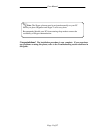
U
U
s
s
e
e
r
r
M
M
a
a
n
n
u
u
a
a
l
l
P
P
a
a
g
g
e
e
8
8
o
o
f
f
3
3
7
7
Setting up your telephone
Connection and conditions for use
You can connect your HS315 to a direct exchange line (DEL), a line connected to a local
exchange, with its own phone number; to an extension socket connected to a DEL; or to
an extension on an approved compatible PBX. Do not connect the HS315 as an extension
to a payphone.
How many phones can you connect?
The ringer equivalence numbers (RENs) of all instruments (phones, fax machines, etc.)
connected to an exchange line must not add up to more than 4, otherwise, one or more of
them may not ring and/or answer calls correctly. The HS315 has a REN of 1, and most
other telephones have a REN of 1unless marked otherwise.
Radio signals between handset and base unit
To use your handset and base unit together, you must be able to establish a radio link
between them. Be aware that:
•
Sitting the base unit as high as possible will give better results, in a two-storey
house, the best position may be on the first-floor landing.
• Any large metal object, like a fridge, a mirror or a filing cabinet, between the
handset and base unit may block the radio signal.
• Other solid structures, like walls, may reduce the signal strength.
Choosing a site for the base unit
The base unit should be placed on a level surface, in a position where:
•
The mains adapter plug will reach a 230 V AC switched mains supply socket;
never try to lengthen the mains power cable.
• The telephone cable will reach your telephone line socket
or extension socket.
• It is not close to another telephone, this can cause radio interference.
•
It is not close to a sink, bath or shower, or anywhere else
where it might get wet.
• It is not close to other electrical equipment, fridges, washing machines,
microwave ovens, TVs, fluorescent lights, etc.


















